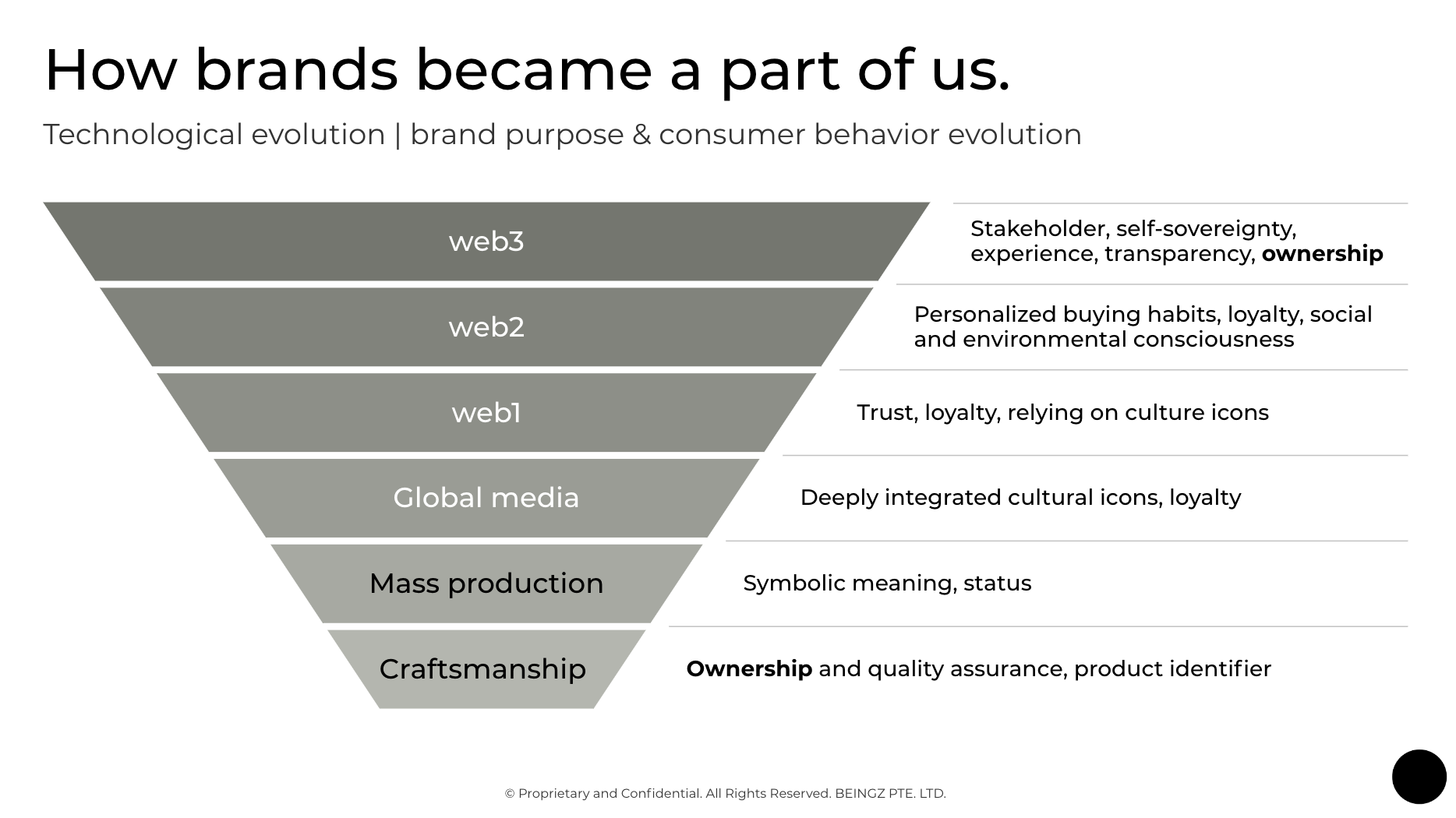Disclaimer: For context purposes, I will start with a historical overview of branding evolution during technological milestones.
What changed?
In an age where identity is currency, decentralized brands are reshaping how we connect, trust, and belong. New ways of human connection make brands more than marketers- they are becoming enablers of shared identity and purpose. It’s simply more possible now for brands and consumers. But what’s changed in how we relate to brands, and why did profit-driven corporate identities become such a central part of our own? As decentralized brands offer more power and involvement, they also risk creating exhaustion- can this shift truly empower us, or will it overwhelm us?
From products to purpose.
Branding has changed with each era. The first purpose of a brand was to help identify a product, represent ownership, and assure quality. What we bought was a clear choice based on function and trust. But as markets grew and competition increased, brands had to become louder and more emotional to stand out, appealing to our desires and aspirations rather than just our practical needs. During the mass production era, brands like Volkswagen symbolized reliability and status, encouraging us to define ourselves through the things we owned.
In the global media age, McDonald’s and Coca-Cola became cultural icons influencing what we consumed and how we saw the world. Advertisements shaped ideals of success, happiness, and belonging, and we often measured our lives against the images they projected.
With social media (web2), brands took on a more personal role. Nike and Ben & Jerry’s started taking stands on political, environmental, and social issues, making us connect with brands on a deeper, emotional level, not just because of the products but because of the values they represented.
We were no longer just consumers but advocates and activists, expressing our beliefs and personalities through the brands we supported.
Now, in web3, brands need to offer transparency, ownership, and a role in shaping their future to stay relevant. We expect to have a say in a brand’s direction and to see our values reflected back at us. We co-create and co-own.

New era: Breaking free from the top-down model.
Brands have operated top-down for centuries, delivering crafted messages to passive consumers. But decentralization flips the switch. The bottom-up dynamics of web3 return ownership to the individual, allowing human beings to build their identities based on personal goals and values rather than being dictated by societal norms or marketing ploys.
But is true decentralization even possible? Most decentralized systems still rely on brands to control narratives, creating a gap between the ideal and reality.
The decentralized brand promise.
Imagine a world where you don’t just consume a brand—you co-create it. Tools like DAOs (Decentralized Autonomous Organizations), tokenized rewards, and blockchain transparency give people the power to shape brand stories. They help to participate, giving consumers the power to co-create and shape brand narratives.
Take Nike’s SWOOSH project, for instance, where communities design and co-create virtual sneakers. Or consider how blockchain guarantees transparency in supply chains, turning buzzwords like “ethical sourcing” into verifiable truths. This allows consumers to shed the label of “buyer” and adopt the role of “stakeholder” or “creator.”
One of the most exciting aspects of decentralization is the idea of shared intellectual property (IP). In traditional models, corporations tightly control IP, limiting how consumers can engage with or benefit from it. Decentralized IP flips this dynamic, allowing consumers to participate in creating, owning, and monetizing brand assets. Communities can co-create logos, designs, or even entire product lines through decentralized systems. Blockchain ensures contributors are recognized and rewarded. This opens doors for fans to become co-owners of the brands they love, creating stronger loyalty and a sense of purpose.
However, even with these promises, the reality of decentralization is complicated. Decision-making often falls to a small group of stakeholders, and these systems can exclude those without access to technology or resources.
Challenges to address.
Decentralization brings real challenges. Balancing personalization with privacy and incentives with integrity is tricky. Many "decentralized" brands still hold significant control. Accessing decentralized brands is still very complicated. Overhype and unrealistic exceptions can lead to disappointment and mistrust.
In a decentralized world with countless DAOs, tokens, and platforms, standing out becomes increasingly difficult. Brands must create compelling, unique value to attract and retain participants.
On a societal level, blockchain’s environmental impact is a concern and complex systems often exclude those who lack technical knowledge. Transparency can also backfire, becoming surveillance or pressuring people to participate constantly. These issues can lead to consumer fatigue and make brands less accessible.
Toward a bottom-up future.
Decentralized brands bring us (hopefully) back to a more human way of connecting, where communities, not corporations, set the rules. Brands now become beings: entities with shared goals, co-created by their communities and held accountable by the values they claim to represent.
In conclusion, the shift toward decentralized brands is another pivotal moment in how we connect with products, values, and each other. While this new model promises greater transparency, ownership, and empowerment, it also brings challenges that can overwhelm consumers, such as complexity, accessibility issues, and the risk of burnout.
As brands shift from top-down control to community-driven collaboration, their success will depend on balancing empowerment with sustainability. Staying true to their values is key. Decentralized brands should create real connections and take participants on their journey, not become an extra burden for people.
One thing is clear to me: The brands that thrive will not be those who hold power but those who share it.
In a future dominated by automation, brands will stand out by standing for something real. Now, they can prove what’s 'real'.
-- mart




评论 (0)